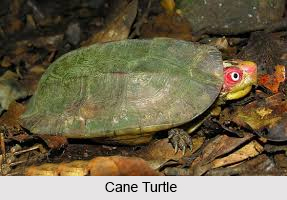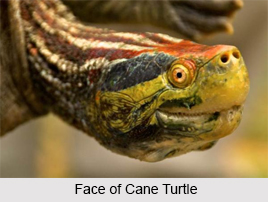 Cochin Forest Cane Turtle is an Indian Reptile that bears a scientific name "Vijayachelys silvatica" is found in the Western Ghats Mountain Range in India.
Cochin Forest Cane Turtle is an Indian Reptile that bears a scientific name "Vijayachelys silvatica" is found in the Western Ghats Mountain Range in India.
Description of Cochin Forest Cane Turtle
Cochin Forest Cane Turtle was described in 1912 by the Indian scientists. It was finally rediscovered in 1982, and since then a number of specimens have been found and some studies have been conducted about its affiliation and habits.
Family of Cochin Forest Cane Turtle
Cochin Forest Cane Turtle belongs to the subfamily Geoemydinae of the family Geoemydidae, formerly known as Bataguridae. It was once placed in the genus Geoemyda and subsequently moved to Heosemys. But as it seems, the Cochin Forest Cane Turtle forms a quite distinct lineage closely related to Melanochelys. Thus, nowadays it is recognized as a monotypic genus, named Vijayachelys in honor of the famous Indian herpetologist Jaganath Vijaya who rediscovered this species in 1982 and until her death extensively studied it.
Carapace of Cochin Forest Cane Turtle
The carapace of Cochin Forest Cane Turtle is considerably depressed, with a prominent mid-line keel, as well as one less pronounced lateral keel on each side. Its posterior margin is feebly reverted and not or only indistinctly serrated.
Nuchal Scute of Cochin Forest Cane Turtle
The Nuchal Scute is small. The first Vertebral Scute is broader in front than behind and larger than the second, third and fourth vertebral shields. These are considerably broader than long, as broad as the Costal Scutes.
Plastron of Cochin Forest Cane Turtle
The plastron is sizeable, being nearly as large as the shell opening; it is connected to the carapace by ligaments and particularly in females there is little ossification between the shields of the shell. The plastron is angled at the sides and openly emarginate at the forward and aft opening. The width of the plastron bridge is less than the length of the hind lobe; the longest median suture is between the abdominal scute, the shortest between the gular scute. The axillary and inguinal scutes are very small; one of the latter is even absent.
 Head of Cochin Forest Cane Turtle
Head of Cochin Forest Cane Turtle
The head of Cochin Forest Cane Turtle is rather large, with a truncated snout as long as the sizeable orbit; the upper jaw is hooked, with small premaxillae. The mandibular symphysis is very long, exceeding the maximum diameter of the orbit in width. On the hind part of the head, the skin is divided into moderately large shields.
Skull of Cochin Forest Cane Turtle
The skull of Cochin Forest Cane Turtle lacks a temporal arch and has the frontal bone extended to form a considerable part of the orbit. Seen from above, the prootic extends towards the front. The jugal does not contact the small laterally emarginated and medially constricted pterygoid process, the bones being separated by the maxilla and a gap. The triturating (chewing) surface of the upper jaw is long and narrow, more than four times as long as it is wide. The lower temporal fossa is large and strongly concave, providing an attachment for the massive chewing muscle.
Limbs of Cochin Forest Cane Turtle
The forelegs of Cochin Forest Cane Turtle are covered in enlarged squarish or pointed horny scales, particularly on the front. The hind limbs are rather club-shaped, the anterior margins and anterior region of their heels bearing enlarged horny scales. The fingers are webbed one-third of their length, while the toes bear rudimentary webbing only. The tail is rather short and becomes very narrow behind the cloaca in males; it is a mere stub in females.
Length of Cochin Forest Cane Turtle
The length of the Cochin Forest Cane Turtle"s shell is 120 mm, its breadth is 83 mm and its depth is 45 mm. Females are slightly larger than males, but this smallish turtle does not seem to exceed about 13 cm in carapace length even when fully grown.
Habitat of Cochin Forest Cane Turtle
Cochin Forest Cane Turtle inhabits dense evergreen forest, presumably at lower elevations. According to the natives from whom Dr. Henderson obtained the type, the species inhabits short burrows underground and is indifferent about having water nearby (unlike some of its relatives, which are decidedly aquatic).
Feeding of Cochin Forest Cane Turtle
Cochin Forest Cane Turtle lived entirely upon vegetable food, but subsequently it has turned out that this turtle is omnivorous, eating any suitably sized plant and animal food.











